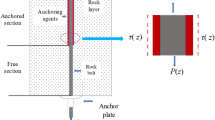Abstract
Based on the test results of the bolt axial strain in three types of high, medium, and low strength respectively, the shear stresses of the internal anchorage section are studied. Then a method for calculating the effective length and ultimate bearing capacity of stretched bolts is established. The bolt effective anchorage length is calculated in different strength media, and several factors affecting the bolt effective anchorage length are analyzed. The results provide some insights into the effective anchorage length of anchorage structures and an applicable method for design and anchor engineering calculation.





Similar content being viewed by others
Data Availability
The data used to support the findings of this study are included and showed within the article.
References
Bai X, Zhang M, Kuang Z et al (2018) Application of fiber grating sensing technology in pull-out test on glass fiber reinforced polymer anti-floating anchor [J]. Rock Soil Mech 39(10):3891–3899. https://doi.org/10.16285/j.rsm.2017.2395
Benmokrane B, Chennouf A, Mitri HS (1995) Laboratory evaluation of cement based grouts and grouted rock anchors [J]. Int J Rock Mech Mining Sci Geomech Abstr 32:633–642. https://doi.org/10.1016/0148-9062(95)00021-8
Chai X J, Hayashi S, Du Y J. (2004) Contribution of dilatancy to pull-out capacity of nails in sandy clay[C]//Int’1 Conference on nailing and Stability of Soil and Rock Engineering, Nanjing
Cui Q, Xing M, Yang W et al (2018) Field pull-out test and design method of the short pile and anchor composite foundation in the Karst area [J]. Chin J Rock Mech Eng 37(11):2621–2630. https://doi.org/10.13722/j.cnki.jrme.2018.0580
Guan R, Huanchun Z, Chuangbing Z (2004) Test study on working mechanism of fully grouted bolts of thread steel and smooth steel [J]. Chin J Rock Mech Eng 23(3):469–475. https://doi.org/10.3321/j.issn:1000-6915.2004.03.021
Hariyadi MS, Sonoda Y (2017) Experimental analysis of anchor bolt in concrete under the pull-out loading [J]. Procedia Eng 171:566–584. https://doi.org/10.1016/j.proeng.2017.01.391
Hongxiao DONG, Junqi FAN, Ran LI (2012) Analysis on the shear stress distribution of internal anchorage section of full-length injected bolt based on mindlin’s displacement solution [J]. Protect Eng 34(6):29–33
Jiru Z, Baofu T (2002) Hyperbolic function model to analyze load transfer mechanism on bolts [J]. Chin J Rock Mech Eng 24(2):187–192
Jun-qi FAN, Hong-xiao DONG, Yong-hong GAO (2014) (2014) Experimental study on the shear stress distribution of internal anchorage section of full-length injected bolt [J]. J Exp Mech 29(2):250–256
Junqi F (2005) Study on the shear stress distribution of internal anchorage section of anchoring-type structure [D]. Lanzhou University, Lanzhou
Liu S, Zhao M, Li L (2014) Analysis of dynamic broken line model based on experimental data of anchor anti-pullout [J]. Rock and Soil Mech 35(12):3389–3395. https://doi.org/10.16285/j.rsm.2014.12.041
Ma S, Nemcik J, Aziz N (2013) An analytical model of fully grouted rock bolts subjected to tensile load [J]. Constr Build Mater 49(1):519–526. https://doi.org/10.1016/j.conbuildmat.2013.08.084
Richard G, Hristophe A, Simon R (2019) Experimental and numerical analysis of in situ pull-out tests on rock bolts in claystones [J]. Europ J Environ Civil Eng 25:1–24. https://doi.org/10.1080/19648189.2019.1626288
Thenevin I, Laura BlancoMartín, Faouzi HadjHassen (2017) Laboratory pull-out tests on fully grouted rock bolts and cable bolts: Results and lessons learned [J]. J Rock Mech Geotech Eng 9:843–855. https://doi.org/10.1016/j.jrmge.2017.04.005
Wang Jianyu, Mou Ruifang. (1998) Calculation on the inner force of bonding bolts in the ground anchor engineering according to Winkler's assumption [A]. In: New Techniques of Rock and Soil Anchorage[C], Beijing: China Communications Press
Windsor CR (1997) Rock reinforcement system [J]. Int J Rock Mech Min Sci 34(6):919–951. https://doi.org/10.1016/S1365-1609(97)80004-4
Wu Shenxing (2004) Dynamic experimental study of bond-slip between bars and the concrete in Xiaowan arch dam [A], In: New Developments in Dam Engineering-Wieland[C]. London Taylor and Francis Group, 2004: 951–959, https://doi.org/10.1201/9780203020678.ch114.
Xianming Z, Shimin LDL et al (2009) Comprehensive research of critical anchorage length problem of rod of anchorage type structure [J]. Chin J Rock Mech Eng 28(S2):3609–3625
Yin YC, Zhao TB, Tan YL et al (2013) Research of stress distribution evolution law and influencing factor [J]. J Mining Safety Eng 30(5):712–716
Zeng Xianming Du, Yunhe FJ et al (2005) Discussion on evolutionary law, attenuating characteristic and calculating method for the shearing stress of the second interface of anchorage type structures [J]. Chin J Rock Mech Eng 24(S1):4611–4626
Zhong-xin JIANG (2001) A Gauss curve model on shear stress along anchoring section of anchoring rope of extensional force type [J]. Chin J Rock Mech Eng 23(6):696–699
Acknowledgements
The authors appreciate the financial support of the National Natural Science Foundation of China (Grant No. 51778215) and China Postdoctoral Science Foundation funded Project (Grant No. 2018M631114).
Author information
Authors and Affiliations
Corresponding author
Ethics declarations
Competing interests
The authors declare that there is no conflict of interest regarding the publication of this paper.
Additional information
Publisher's Note
Springer Nature remains neutral with regard to jurisdictional claims in published maps and institutional affiliations.
Rights and permissions
About this article
Cite this article
Fan, J., Shi, X., Kong, F. et al. Calculation Method of the Effective Anchorage Length of Anchorage Structures Based on Analysis of the Ultimate Bearing Capacity. Geotech Geol Eng 39, 4205–4212 (2021). https://doi.org/10.1007/s10706-021-01751-w
Received:
Accepted:
Published:
Issue Date:
DOI: https://doi.org/10.1007/s10706-021-01751-w



